
The family Phylliidae contains the extant true leaf insects or walking leaves, which include some of the most remarkably camouflaged leaf mimics (mimesis) in the entire animal kingdom. They occur from South Asia through Southeast Asia to Australia. Earlier sources treat Phylliidae as a much larger taxon, containing genera in what are presently considered to be several different families.
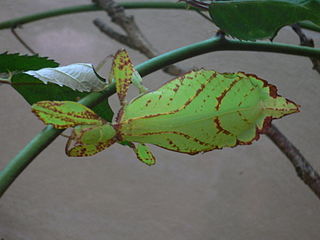
Phyllium is the largest and most widespread genus of leaf insects in the family Phylliidae (Phasmatodea). They can be found in Sundaland, Philippine Islands, Wallacea, and Australasia.
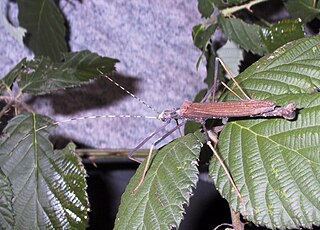
Pseudophasmatidae is a family of stick insect, in the suborder Verophasmatodea, commonly called the "striped walkingsticks". An important identifying characteristic is its mesothorax, which is never more than three times as long as the prothorax.
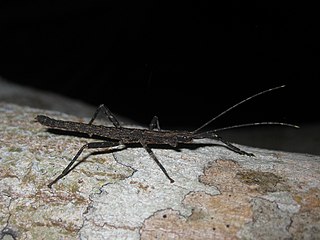
Malacomorpha is a genus of striped walkingsticks in the family Pseudophasmatidae. There are about 15 described species in the genus Malacomorpha.
Nanophyllium brevipenne, is a species of phasmid or leaf insect of the genus Nanophyllium. It is found in New Guinea, and Sri Lanka.

Sipyloidea is a genus of stick insects of the family Lonchodidae. Species have been recorded from India, China, Indochina, through to Australasia. The genus was described by Brunner von Wattenwyl in 1893.
Canuleius is a genus of walkingsticks in the family Heteronemiidae. There are at least 20 described species in Canuleius.
Dajaca is a genus of stick insects belonging to the suborder Verophasmatodea, family Aschiphasmatidae and is the only representative of the monotypic tribe Dajacini. Species have been recorded from Borneo, Vietnam, Hong Kong and Myanmar.

Cryptophyllium westwoodii is a species of leaf insect in the family Phylliidae. It is distributed from southern China, the Andaman islands, Myanmar, Indo-China, Sumatra and the Riouw Archipelago.
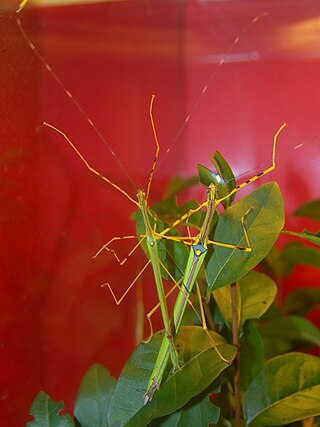
Necroscia is an Asian genus of stick insects in the family Lonchodidae and tribe Necrosciini. Species have been recorded from South-East Asia.

Pylaemenes is a genus of stick insects in the family Heteropterygidae and subfamily Dataminae. It combines small to medium-sized, often brightly colored Phasmatodea species. Their representatives are found in large parts of Southeast Asia.
Ramulus westwoodii is a species of stick insect first described by James Wood-Mason in 1873 and named in honour of John O. Westwood.
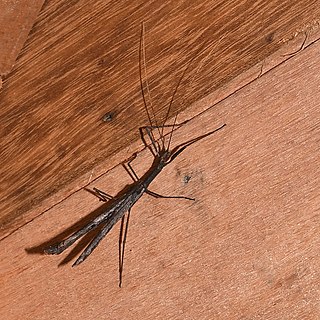
Isagoras is a genus of striped walkingsticks in the family Pseudophasmatidae. There are more than 25 described species in Isagoras.

Phyllium letiranti is a species of phasmid or walking leaf of the genus Phyllium. It is only found on the island of Peleng in Indonesia.
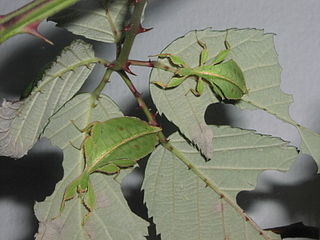
Cryptophyllium is a genus of leaf insects in the tribe Phylliini, described in 2021. Its distribution is probably incomplete, but includes southern China, Sri Lanka, Indo-China, Malesia and western Pacific islands.
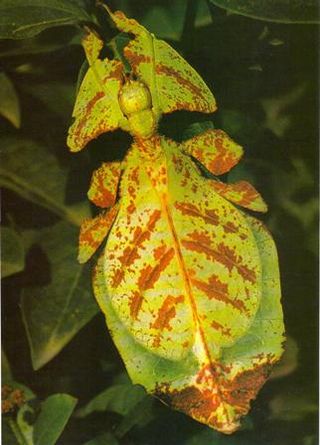
Pulchriphyllium is a genus of leaf insects. It was first established by Griffini in 1898 as a subgenus within the genus Phyllium and is a valid genus since 2021. The distinctive feature of Pulchriphyllium is the presence of lobes on the inside and outside of the fore tibia. In Phyllium are lobes only present on the outside. The representatives of the genus are native to both Sundaland and continental Asia.
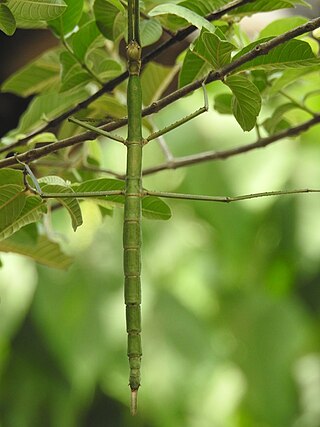
Nesiophasma is a genus of very large stick insects within the order Phasmatodea and the tribe of Stephanacridini. This genus is found in Wallacea west of Weber’s Line: Sulawesi, Peleng Island, Selayar Island, Kalaotoa Island, Sanana Island, Romang Island, Timor Island, Sangihe Island and Talaud Islands. New Guinea with doubt. The largest in the list of species is Nesiophasma giganteum, with females reaching a body length of 30 cm.

Neohirasea is a genus of stick insects in the tribe Necrosciini, erected by J.A.G. Rehn in 1904. Species has been recorded from temperate and tropical Asia, including: China, India, Japan, Malaysia and Vietnam.
Scionecra is a genus of Asian stick insects in the tribe Necrosciini, erected by Heinrich Hugo Karny in 1923. Species have been recorded from: China, Vietnam, Malesia through to Australia.

Nanophyllium australianum, also known as the Queensland leaf insect, is a species of leaf insect found in the Iron Range in Northern Queensland.















